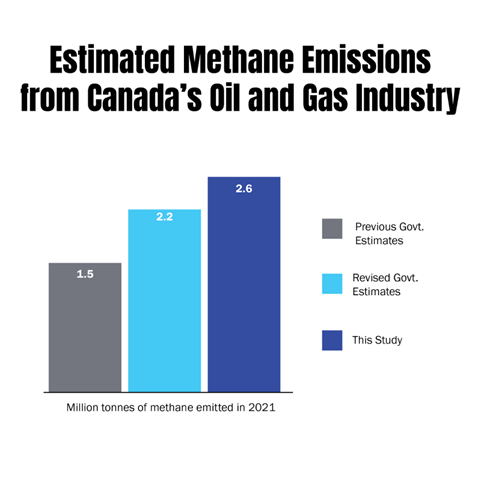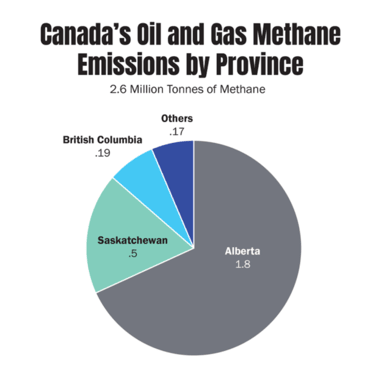New Study Provides Comprehensive Estimates of Methane Emissions from Canada’s Oil and Gas Industry Based on Direct Measurements
New peer-reviewed research published this week provides new and much-needed clarity about the methane footprint created by Canada’s oil and gas industry and the country’s progress toward addressing it.
According to this latest research, Canada’s oil and gas industry emitted 2.6 million tonnes of methane gas into the atmosphere in 2021. That’s over 2% of the total gas produced nationwide.
Methane is a potent greenhouse gas that’s fueling the climate change crisis. Canada has made a commitment to reduce 75% of oil and gas methane emissions by 2030, but gaps in methane data have made it difficult to assess whether Canada can meet that target.
Previous studies of Canada’s methane emissions have found that methane levels are often two- to five-times higher than reported in various inventories and government estimates. In April 2024, the Canadian government updated its methods for estimating methane emissions – basing some estimates on direct measurements as opposed to models or estimates. The study released today confirms this new approach provides much more accurate estimates of national methane levels and makes it easier to correctly track progress toward reducing methane.

“Understanding how much methane is being emitted and where it’s coming from is crucial to reducing pollution,” said Katlyn MacKay, lead author of the study. “By analyzing real data collected by scientists throughout the years, we now have a much clearer picture of what steps we can take to help address methane emissions as quickly and effectively as possible.”
WATCH: Researchers study methane emissions in Canada’s oil fields
Methods
Previous research on Canada’s oil and gas methane evaluated emissions from specific sources – such as flares or tanks — or from specific energy-producing regions. This is the first comprehensive analysis that looks at direct measurements taken across the supply chain nation-wide, providing both national and province/territory emission estimates.
Opportunities for improvement
About 90% of the oil and gas industry’s methane emissions come from production sites (leaks from equipment such as oil wells, tanks or from intentional venting) indicating that efforts to reduce emissions should target these types of facilities. However, the study also revealed there is huge variability between oil- and gas-producing provinces. For example, Saskatchewan is the second highest methane emitter in terms of volume, but it’s wasting a disproportionate amount of gas compared to fellow energy producing provinces. Saskatchewan emits nearly 20% of its gas into the atmosphere – ten times more than the national average.
The wide variability between regions indicates provincial methane policies will likely need to be modified and strengthened in order for Canada to meet its national reduction targets.

"This new research shows that there is still a lot of work to be done in all major oil and gas producing provinces, and especially in Saskatchewan where industry is far more polluting,” said Ari Pottens, Senior Campaign Manager, Canada.” We know that methane mitigation is among the cheapest and fastest ways to slow climate change, and we’re counting on provincial and federal governments to step in with strong regulations that will deliver meaningful reductions."
The measurement methods analyzed in this study as well as new advancements in methane-detecting technology are making it easier for countries to track emissions and target areas for reductions. Canada recently committed to developing a Centre of Excellence for methane monitoring with the goal of improving the way it measures and manages methane emissions. The results of this study indicate that such efforts will be greatly beneficial to help Canada achieve its climate goals.
With more than 3 million members, Environmental Defense Fund creates transformational solutions to the most serious environmental problems. To do so, EDF links science, economics, law, and innovative private-sector partnerships to turn solutions into action. edf.org
Media Contact
Latest press releases
-
Trump Administration Announces Unlawful Offshore Wind Halt
December 22, 2025 -
Governor Hochul Repeals "100-Foot Rule," Accelerating New York's Clean Energy Future
December 19, 2025 -
Colorado Air Regulators Approve Landfill Methane Standards
December 18, 2025 -
Proposal Would Guarantee Public Access to Air Quality Data
December 18, 2025 -
New Bill Will Help Keep Domestic Manufacturers Competitive
December 17, 2025 -
Satellite Data Shows Colorado Oil & Gas Methane Emissions Dropped as State Rules Took Effect
December 17, 2025










